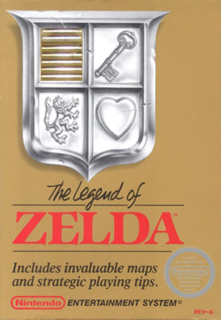It stands to reason that the Legend of Zelda is beginning to be fondly remembered for all of the wrong reasons, to the point where gamers are pretty much looking for flaws in the formula that sound more like tiny nitpicks instead of major designing missteps. Yes, the original stands as a clearly perfect version of what Shigeru Miyamoto intended the game to be at the time, but times often change, and with it, the design philosophy of a budding series. Regardless of anyone’s preferred Zelda experience (2D Vs 3D, narrative-driven Vs explorative-drive,) it often seems like a complete waste of time and energy to insist that one game in the franchise is the definitive experience, especially since Zelda has always been about pushing the envelope in terms of technical mastery and artistic expression. With that said… yeah, the original Legend of Zelda is still my favorite.
Surprising almost no one, the Legend of Zelda for the Nintendo Entertainment System still holds up after thirty years passed its initial release. It’s the only game in the series (at least until Breath of the Wild is released in 2017) that features a truly open-ended design which turns the world in a sandbox, while its dungeons, though artistically homogenized, are masterfully designed, its challenge never being overbearing, and its world ever so whimsical, even for an early period NES game.
Set in the land of Hyrule, the titular princess has been captured by an evil pig wizard named Ganon, who is in search of a powerful artifact called the triforce of wisdom, after possessing the triforce of power. Whoever has both triforces will rule Hyrule for all of eternity. Before her capture, Zelda scatters the wisdom triforce into eight pieces and dispersed them all over Hyrule. The player amuses the role of Link, a young woodsman who sets out to find the pieces of the triforce and rescue the princess, Zelda. Believe it or not, that’s the whole story. While the plot isn’t as rich as other game in the series, it at least puts the player’s action in perspective of the game’s world.
The meat and potatoes are within the game’s world itself; the world is open to the player just as soon as the start button is hit, and the game can literally be tackled in any fashion the player sees fit. Items can be missed entirely, there are no arbitrarily blocked paths, and the leveled dungeons can be explored completely out of order, making it a truly opened world. There’s only one particular rule of the game; you cannot attempt the final level until you gather all eight pieces of the triforce. But other than that, the world of Hyrule is the player’s oyster. The only gripe with the game’s design is that it’s amazingly cryptic; the game’s overworld map is just a funky-ass gray box, the non-playable character give out very vague information, like “Dadongo dislikes smoke” and “Grumble, grumble,” and looking for secret usually leads to resource depletion giving that none of them have tells.
The Legend of Zelda is imagination incarnate, inspired by Shigeru Miyamoto’s childhood excursion and western fairytales. It’s no wonder why of this lone game’s design has inspired fierce debates amongst its fanbase; it’s so well executive that it’s a wonder why subsequent games have deviated from its open-ended roots. I don’t find that to be a bad thing; there was never ever anything inheritably wrong with a more linear design, and more often than not, I personally prefer a more linear adventure since I'm already devoting a good portion of my time to any game really, so it’s best to get to the point. With that said, the Legend of Zelda is indeed the best version of exactly what it wants to be for the time of its release, still one of the most all-time influence games considering that it’s apparently returning to said form with 2017’s Breath of the Wild and the aforementioned Dark Souls series, and remains one of the greatest games ever made.

